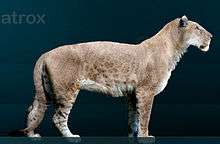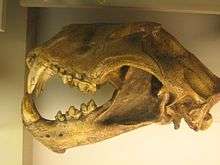American lion
| Panthera leo atrox Temporal range: Pleistocene, 0.34–0.011 Ma | |
|---|---|
 | |
| Skeleton from the La Brea tar pits at the George C. Page Museum | |
| Scientific classification | |
| Kingdom: | Animalia |
| Phylum: | Chordata |
| Class: | Mammalia |
| Order: | Carnivora |
| Family: | Felidae |
| Genus: | Panthera |
| Species: | P. leo |
| Subspecies: | †P. l. atrox |
| Trinomial name | |
| Panthera leo atrox Leidy, 1853 | |
The American lion (Panthera leo atrox or P. atrox[note 1]) – also known as the North American lion, Naegele’s giant jaguar or American cave lion – is an extinct lion of the family Felidae, endemic to North America during the Pleistocene epoch (340,000 to 11,000 years ago), existing for about 0.33 million years.[2] It has been shown by genetic analysis to be a sister lineage to the Eurasian cave lion (Panthera leo spelaea or P. spelaea).[1] It was part of the abundant Pleistocene megafauna, a wide variety of very large mammals that lived at the time. The most abundant remains have come from the La Brea Tar Pits.
The American lion is one of the largest types of cat ever to have existed, slightly larger than the early Middle Pleistocene primitive cave lion, P. leo fossilis and about 25% larger than the modern African lion.[3]
Description

The head-body length of the American lion is estimated to have been 1.6–2.5 m (5 ft 3 in–8 ft 2 in)[4] and it would have stood 1.2 m (3.9 ft) at the shoulder. Thus, it was smaller than its contemporary competitor for prey, the giant short-faced bear, which was the largest carnivoran of North America at the time. The American lion was not as heavily built as the saber-toothed cat, Smilodon populator, which may have weighed up to 400 kg (880 lb).[5] Sorkin (2008) estimated the American lion to weigh roughly 420 kg (930 lb),[6][7] but a more recent study showed an average weight for males of 256 kg (564 lb) and 351 kg (774 lb) for the largest specimen analyzed.[8]
Around 100 specimens of the American lion have been recovered from the La Brea Tar Pits in Los Angeles, so their body structure is well known. The features and teeth of this extinct lion strongly resemble those of modern lions, but they were considerably larger, and are believed to be the largest subspecies of lion.
Taxonomy

The American lion was initially considered a distinct species of Pantherinae, with the scientific name Panthera atrox /ˈpænθərə ˈætrɒks/, which means "cruel" or "fearsome panther" in Latin. Overall, the skull of this cat was most like that of the jaguar (P. onca). Some later authors accepted this view, but other experts considered the American lion most closely related to the African lion (P. leo) and its extinct Eurasian relative, the cave lion (P. leo spelaea or P. spelaea). Later paleontologists assigned the extinct American cat as a subspecies of P. leo (P. leo atrox) rather than as a separate species.[8][note 1]
Cladistic studies using morphological characteristics have been unable to resolve the phylogenetic position of the American lion. At least one authority considers the American lion (along with the cave lion), to be more closely related to the tiger, P. tigris, citing a comparison of skull shapes; the braincase, in particular, appears to be especially similar to the braincase of a tiger.[9] The American lion and Eurasian cave lion were also suggested to be successive offshoots of a lineage leading to an extant lion-leopard clade.[10] A more recent study comparing the skull, jaw, and teeth of the American lion with other pantherines concluded it was not a lion and was distinct from all extant species. The authors suggested it may have arisen from pantherines that migrated into North America in the mid-Pleistocene epoch and gave rise to both American lions and jaguars (P. onca).[8] Another morphological study grouped the American lion with P. leo and P. tigris, and ascribed similarities to P. onca to convergent evolution.[11]

However, mitochondrial DNA sequence data from remains of the American lion from Wyoming and Alberta show it is a sister lineage to the cave lion, and likely arose when an early cave lion population became isolated south of the North American continental ice sheet. The most recent common ancestor of the two populations apparently lived about 340,000 (194,000–489,000) years ago.[1] The most recent common ancestor of the P. atrox lineage is estimated to have lived about 200,000 (118,000–246,000) years ago. The dates imply that genetic isolation from P. spelaea had begun by the time of the Illinoian glaciation, about 300,000–130,000 years ago (a spelaea population is known to have been present in eastern Beringia by that period, where it persisted until at least 11,925 ± 70 years ago[1]). This separation was maintained during the Sangamon interglacial, about 130,000–110,000 years ago, as well as during later interstadials of the earlier glaciation and those of the following Wisconsinan glaciation, about 110,000–10,000 years ago. Boreal forest may have contributed to the separation during warmer intervals; alternatively, a species barrier may have existed.[1] The study also indicates the present-day lion is the closest extant relative of P. atrox and P. spelaea.[1] (The same study shows Eurasian and Beringian cave lions to be genetically indistinguishable.[1])
Distribution
The earliest lions known in the Americas south of Alaska are from the Sangamonian Stage - the last interglacial - following which, the American lion spread widely from Alberta to Maryland, reaching as far south as Chiapas, Mexico.[12] It has been found in more locations in the west of North America than in the east.[13] It was generally not present in the same areas as the jaguar, as the latter favored forests, while American lions preferred open habitats.[4] The American lion was formerly believed to have colonized northwestern South America as part of the Great American Interchange.[14] However, the fossil remains found in the tar pits of Talara, Peru actually correspond to an unusually large jaguar.[15][16][17] Like many other large mammals, it became extinct at the end of the Pleistocene. The most recent fossil, from Edmonton, dates to 11,355 ± 55 years ago.[1]
Habitat

In some areas of its range, the American lion lived under cold climatic conditions. They probably used caves or fissures for shelter from the cold weather.[18] They may have lined their dens with grass or leaves, as the Siberian tiger does, another great cat that currently lives in the north.[18]
Fewer American lions are in the La Brea tar pits than other predators such as saber-toothed cats (Smilodon fatalis) or dire wolves (Canis dirus), which suggests they may have been smart enough to avoid the hazard.[3] American lions likely preyed on North American deer, horses (now extinct), camels, and tapirs, and American bison, mammoths, and other large, herbivorous animals.[18][19] Evidence for predation on bison by American lions is particularly strong as a freeze-dried carcass nicknamed "Blue Babe" was discovered in Alaska and bears bite and claw marks from lions. Based on the largely intact nature of the carcass, the bison was frozen before the lions could devour the meat.[20] This species disappeared about the same time as other megafaunal species during the Quaternary extinction event, which wiped out many of the species on which the American lion would have preyed. Lion bones have been found in the trash heaps of Paleolithic American Indians, suggesting human predation may have contributed to its extinction.[4][18]
A replica of the jaw of the first specimen of American lion discovered can be seen in the hand of a statue of paleontologist Joseph Leidy, which is currently standing outside the Academy of Natural Sciences in Philadelphia.
Notes
References
- 1 2 3 4 5 6 7 8 Barnett, R.; Shapiro, B.; Barnes, I. A. N.; Ho, S. Y. W.; Burger, J.; Yamaguchi, N.; Higham, T. F. G.; Wheeler, H. T.; Rosendahl, W.; Sher, A. V.; Sotnikova, M.; Kuznetsova, T.; Baryshnikov, G. F.; Martin, L. D.; Harington, C. R.; Burns, J. A.; Cooper, A. (2009). "Phylogeography of lions (Panthera leo ssp.) reveals three distinct taxa and a late Pleistocene reduction in genetic diversity". Molecular Ecology. 18 (8): 1668–1677. doi:10.1111/j.1365-294X.2009.04134.x. PMID 19302360.
- ↑ Strauss, Bob. "American Lion (Panthera leo atrox)". About.Com Dinosaurs. The New York Times Company. Retrieved 2012-03-10.
- 1 2 Deméré, Tom. "SDNHM Fossil Field Guide: Panthera atrox". Archived from the original on 2009-06-25. Retrieved 2010-05-18.
- 1 2 3 Anderson, Elaine (1984), "Who's Who in the Pleistocene: A Mammalian Bestiary", in Martin, P. S.; Klein, R. G., Quaternary Extinctions, The University of Arizona Press, ISBN 0-8165-1100-4
- ↑ Christiansen, P.; Harris, J. M. (2005-10-18). "Body size of Smilodon (Mammalia: Felidae)". Journal of Morphology. 266: 369–384. doi:10.1002/jmor.10384. PMID 16235255. Retrieved 2012-03-10.
- ↑ Sorkin, B. (2008-04-10). "A biomechanical constraint on body mass in terrestrial mammalian predators". Lethaia. 41 (4): 333–347. doi:10.1111/j.1502-3931.2007.00091.x. Retrieved 2011-08-02.
- ↑ Merriam, J. C. & Stock, C. 1932: The Felidae of Rancho La Brea. Carnegie Institution of Washington Publications 442, 1–231.
- 1 2 3 Christiansen, Per, & Harris, John M. (2009). "Craniomandibular Morphology and Phylogenetic Affinities of Panthera atrox: Implications for the Evolution and Paleobiology of the Lion Lineage". Journal of Vertebrate Paleontology. 29 (3): 934–945. doi:10.1671/039.029.0314.
- ↑ Groiss, J. Th. (1996): Der Höhlentiger Panthera tigris spelaea (Goldfuss). Neues Jahrb. Geol. Paläont. Mh. Vol.7, p.399–414.
- ↑ Christiansen, Per (2008-08-27). "Phylogeny of the great cats (Felidae: Pantherinae), and the influence of fossil taxa and missing characters". Cladistics. 24 (6): 977–992. doi:10.1111/j.1096-0031.2008.00226.x. Retrieved 2011-12-08.
- ↑ King, L. M.; Wallace, S. C. (2014-01-30). "Phylogenetics of Panthera, including Panthera atrox, based on craniodental characters". Historical Biology: 1. doi:10.1080/08912963.2013.861462.
- ↑ Marisol Montellano, Ballesteros; Carbot-Chanona, Gerardo. "Panthera leo atrox (Mammalia: Carnivora: Felidae) in Chiapas, Mexico". The Southwestern Naturalist. 54 (2): 217–222. doi:10.1894/clg-20.1.
- ↑ "Panthera leo atrox". Paleobiology Database. Retrieved 2012-03-11.
- ↑ Kurtén, B., and E. Anderson. 1980. Pleistocene mammals of North America. Columbia University Press, New York
- ↑ Seymour, K. L. (1983). The Felinae (Mammalia: Felidae) from the Late Pleistocene tar seeps at Talara, Peru, with a critical examination of the fossil and recent felines of North and South America. MSc thesis, University of Toronto.
- ↑ Seymour, K. 2015. Perusing Talara: Overview of the Late Pleistocene fossils from the tar seeps of Peru. Natural History Museum of Los Angeles County Science Series, 42: 97-109
- ↑ Yamaguchi, N.; Cooper, A.; Werdelin, L.; MacDonald, D. W. (2004). "Evolution of the mane and group-living in the lion (Panthera leo): A review". Journal of Zoology. 263 (4): 329. doi:10.1017/S0952836904005242.
- 1 2 3 4 Harington, C.R. (1996). "American lion". Yukon Beringia Interpretative Center. Archived from the original on 12 March 2012. Retrieved 10 March 2012.
- ↑ Gelbart, Mark (2010-07-28). "Panthera atrox! What Kind of Cat was it?". Georgia Before People. WordPress.com. Retrieved 2012-03-10.
- ↑ Turner, Alan; Anton, Mauricio (1997). The Big Cats and Their Fossil Relatives.
| Wikispecies has information related to: Panthera leo atrox |
| Wikimedia Commons has media related to American lion. |